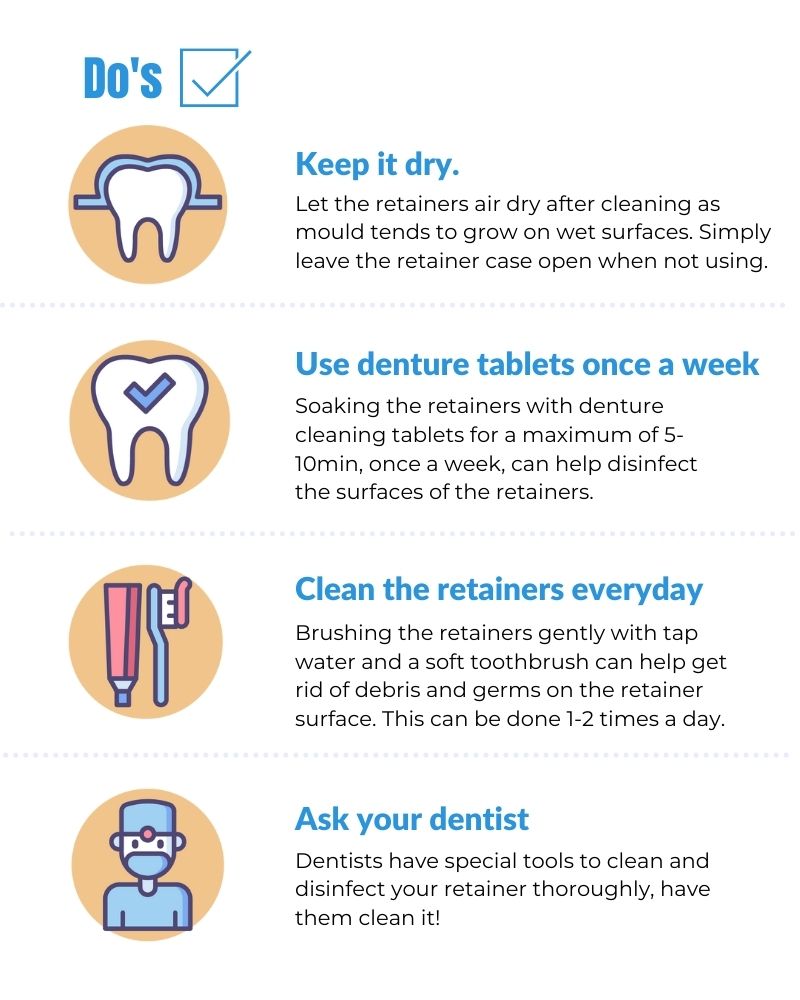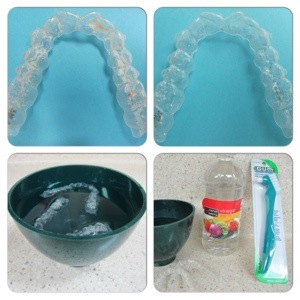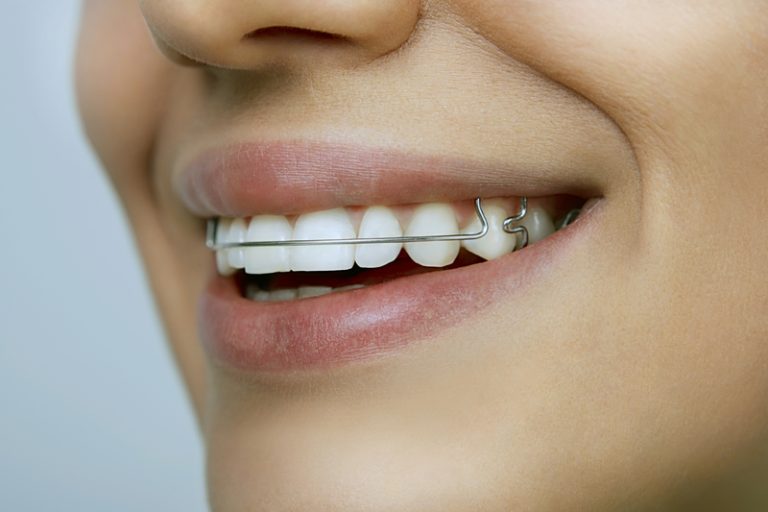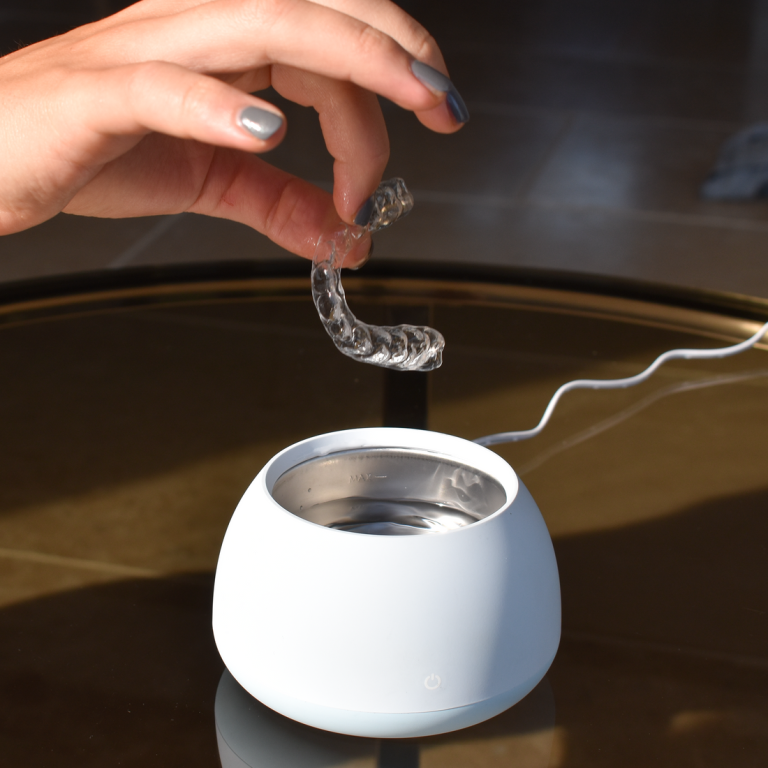How to Clean Retainers at Home: Easy and Effective Tips
Last Updated on 1 month by DR. ALBIN SIPES
Cleaning retainers at home is essential for oral hygiene. Regular cleaning prevents bacteria buildup and keeps your retainer fresh.
Retainers are vital for maintaining teeth alignment after braces. But they need proper care. Neglecting to clean them can lead to bad breath and infections. Luckily, cleaning retainers at home is simple and cost-effective. This guide will walk you through easy steps to keep your retainer spotless.
Whether you have a clear or metal retainer, knowing the right cleaning methods ensures it stays effective and comfortable. Keep reading to learn how to maintain your retainer and keep your smile healthy and bright.

Importance Of Cleaning Retainers
Cleaning retainers is crucial for maintaining good oral health. Dirty retainers can harbor bacteria and cause bad breath. Regular cleaning ensures your retainers stay fresh and effective. It also prevents oral infections and plaque build-up.
Avoiding Bacteria Build-up
Bacteria thrive in moist environments like retainers. When retainers are not cleaned properly, bacteria can multiply. This can lead to oral infections, bad breath, and other health issues. To avoid bacteria build-up, rinse your retainers daily.
Use a soft toothbrush to gently scrub away food particles. Avoid using harsh chemicals that can damage your retainers. Instead, use mild soap or baking soda. Soak your retainers in a cleaning solution once a week for a deeper clean.
Maintaining Oral Hygiene
Oral hygiene is essential for a healthy mouth. Clean retainers contribute to overall oral health. They prevent plaque and tartar build-up. This helps keep your teeth and gums healthy.
Brushing and flossing daily is not enough if your retainers are dirty. Clean retainers ensure that bacteria do not transfer to your teeth. This reduces the risk of cavities and gum disease. Make cleaning your retainers a part of your daily oral care routine.
| Cleaning Method | Frequency | Instructions |
|---|---|---|
| Rinsing | Daily | Rinse with lukewarm water after meals |
| Brushing | Daily | Use a soft toothbrush with mild soap |
| Soaking | Weekly | Soak in a cleaning solution for 10-15 minutes |
Daily Cleaning Routine
Keeping your retainers clean is essential for maintaining oral hygiene. A simple daily cleaning routine can help prevent bacteria and plaque buildup. Follow this guide to ensure your retainers stay fresh and clean.
Rinsing After Each Use
Make it a habit to rinse your retainers after each use. This helps remove debris and prevents plaque buildup. Use lukewarm water to avoid damaging the material. Cold water won’t clean effectively and hot water can warp the retainers.
Brushing With Soft Toothbrush
Brush your retainers gently with a soft toothbrush. Use a mild, non-abrasive toothpaste. Avoid whitening toothpastes, as they can scratch the surface. Brush all surfaces, including the inner parts.
| Step | Description |
|---|---|
| 1 | Rinse retainers with lukewarm water. |
| 2 | Apply a small amount of mild toothpaste. |
| 3 | Brush retainers with a soft toothbrush. |
| 4 | Rinse retainers thoroughly. |
Remember, a consistent daily cleaning routine helps keep your retainers in top shape. Following these steps will ensure your retainers remain clean and free from harmful bacteria.
Deep Cleaning Methods
Retainers require regular cleaning to maintain their condition and your oral health. Deep cleaning methods are essential to remove stubborn stains and bacteria. Let’s explore two effective deep cleaning methods for your retainers.
Soaking In Retainer Cleaner
Soaking your retainer in a retainer cleaner is one of the best methods. Follow these steps:
- Fill a cup with lukewarm water.
- Add the retainer cleaner tablet to the water.
- Place your retainer in the solution.
- Let it soak for 15-20 minutes.
- Rinse thoroughly with water.
This method kills bacteria and removes plaque. It keeps your retainer fresh and clean.
Using Baking Soda Solution
Baking soda is another great option for deep cleaning. Follow these steps:
- Mix one tablespoon of baking soda with one cup of water.
- Stir the solution until the baking soda dissolves.
- Place your retainer in the mixture.
- Let it soak for 15 minutes.
- Rinse well with lukewarm water.
Baking soda is a natural cleaner. It is safe and removes odors from your retainer.
Natural Cleaning Alternatives
Keeping your retainers clean is essential for your oral hygiene. Using natural cleaning alternatives is both safe and effective. Here are some easy methods you can try at home.
Vinegar And Water Mix
A vinegar and water mix is a simple and natural solution. Here’s how to make it:
- Mix equal parts of white vinegar and warm water.
- Soak your retainer in this solution for 15-30 minutes.
- Use a soft toothbrush to scrub off any plaque or debris.
- Rinse thoroughly with cool water.
This method helps to kill bacteria and remove odors from your retainer.
Hydrogen Peroxide Solution
A hydrogen peroxide solution can also be effective. Follow these steps:
- Mix one part hydrogen peroxide with one part water.
- Soak the retainer for 30 minutes.
- Gently brush it with a soft toothbrush.
- Rinse well with cool water.
This method disinfects and whitens your retainer without using harsh chemicals.
| Cleaning Solution | Ingredients | Soaking Time |
|---|---|---|
| Vinegar and Water Mix | White vinegar, warm water | 15-30 minutes |
| Hydrogen Peroxide Solution | Hydrogen peroxide, water | 30 minutes |
Using these natural methods helps maintain your retainer’s cleanliness and prolongs its lifespan.
Avoiding Harmful Practices
Cleaning your retainers at home is essential for maintaining good oral hygiene. But it’s crucial to avoid harmful practices that could damage your retainers. Knowing what not to do is just as important as knowing the right cleaning methods.
Steering Clear Of Hot Water
Hot water can warp your retainers. This will affect their fit and comfort. Always use lukewarm or cool water. Hot water can also damage the plastic components of your retainers.
Here’s a quick table to summarize:
| Water Temperature | Effect on Retainers |
|---|---|
| Hot | Warps and damages |
| Lukewarm | Safe |
| Cool | Safe |
Avoiding Harsh Chemicals
Harsh chemicals can erode your retainers. This includes bleach, alcohol-based solutions, and abrasive cleaners. These substances can cause discoloration and wear down the material.
Instead, use gentle cleaning solutions. Consider these options:
- Mild dish soap
- Retainer cleaning tablets
- Non-alcoholic mouthwash
These products clean effectively without causing harm. Always rinse thoroughly after cleaning to remove any residue.

Storing Retainers Properly
Ensuring your retainers are stored correctly is crucial for their longevity. Proper storage prevents damage and maintains cleanliness. Follow these steps to keep your retainers in top condition.
Using A Protective Case
Always use a protective case for your retainers. This prevents physical damage and contamination. A sturdy case offers protection from accidental drops and pressure. Make sure the case is ventilated to avoid moisture build-up.
| Protective Case Features | Benefits |
|---|---|
| Ventilated | Prevents moisture and odor |
| Sturdy | Protects from physical damage |
Keeping Away From Pets
Pets are curious and can easily damage retainers. Always keep your retainers out of their reach. Store the case in a high place or closed drawer. This prevents accidental chewing and contamination.
- Place the case on a shelf
- Store in a closed drawer
- Keep away from pet access areas
Signs Your Retainer Needs Replacement
Retainers are essential for maintaining your teeth alignment. Over time, they can wear out and need replacement. Identifying the signs your retainer needs replacement is crucial to ensure it remains effective. Here are some tell-tale signs to look out for:
Visible Wear And Tear
Inspect your retainer regularly for visible wear and tear. Cracks, chips, or other damage indicate it’s time for a new one. Even small cracks can worsen over time, affecting the retainer’s function. A damaged retainer may not fit well, leading to discomfort and less effective teeth alignment.
| Sign | Action Required |
|---|---|
| Cracks | Replace immediately |
| Chips | Replace immediately |
| Loose fit | Consult your orthodontist |
Persistent Odor Or Discoloration
A clean retainer should be free of persistent odor or discoloration. If your retainer smells bad despite regular cleaning, it might be harboring bacteria. This can affect your oral health. Discoloration is another sign. A yellow or brown retainer is less effective and can be unhygienic.
- Check for unusual smells after cleaning
- Look for yellow or brown stains
- If the retainer remains discolored, replace it
By keeping an eye on these signs, you can ensure your retainer stays effective and hygienic. Regular inspections and proper cleaning will help maintain your oral health.

Consulting Your Orthodontist
Keeping your retainers clean is important for oral health. But it’s equally crucial to consult your orthodontist for professional guidance. Your orthodontist can provide tailored advice, ensuring your retainers remain in top condition.
Regular Check-ups
Regular check-ups with your orthodontist are essential. These visits help to identify any potential issues with your retainers. They ensure that your retainers fit properly and perform their function.
During check-ups, the orthodontist will check for any signs of damage. They will also assess the cleanliness of your retainers. Regular visits can prevent problems before they become serious.
Professional Cleaning Recommendations
Your orthodontist may recommend professional cleaning for your retainers. This is especially important if you notice persistent stains or buildup. Professional cleanings use specialized tools and techniques to clean retainers thoroughly.
The orthodontist might suggest specific cleaning products. These products are designed to be safe and effective for use on retainers. Follow your orthodontist’s advice to ensure the best care for your retainers.
In summary, consulting your orthodontist ensures that your retainers are well-maintained. Regular check-ups and professional cleaning recommendations are key components of this process.
Conclusion
Keeping your retainers clean at home is simple and vital. Regular cleaning prevents bacteria buildup. Use mild soap or a gentle toothbrush. Avoid harsh chemicals. Rinse thoroughly with water. Soak in a retainer cleaner solution weekly. Always handle with care.
Your oral health will thank you. Follow these easy steps for a fresh, clean retainer. A clean retainer means a healthy smile. Now, you can confidently maintain your retainers. Stay consistent for best results. Your mouth deserves it.



